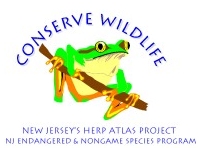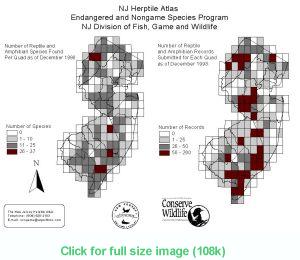| New Jersey Division of Fish, Game, and Wildlife |
|

What is the Herp Atlas?
The New Jersey Herptile Atlas, headed by the New Jersey Division of Fish, Game and Wildlife’s Endangered & Nongame Species Program (ENSP), is a quantitative survey of all reptile and amphibian species throughout the state. The atlas is a part of New Jersey’s Landscape Project, which is designed to provide active management and habitat protection through the cooperative efforts of land managers, state regulators, local planners and citizens.
The Herp Atlas, through the efforts of ENSP and its many volunteers, is collecting data on the specific location and abundance of all reptile and amphibian species in the state. This data will be used to map the critical habitat, abundance, and distribution of our state’s herp species. These maps will provide ENSP with the necessary data to inform planning agencies statewide of the status of New Jersey’s native herp species, thus allowing all agencies to better plan for our state’s wildlife conservation.
The New Jersey Herptile Atlas:
Telephone: (609) 628-2103
E-mail: nongame@algorithms.com.
Herp Atlas Volunteers
The role of the volunteer in a project such as this is critical. Funding for the Herp Atlas comes from the Tax Check-Off for wildlife, the Conserve Wildlife license plates and direct donations. Therefore, the fieldwork conducted and donations given by our volunteers are priceless.
The success of this program is directly tied to the enthusiasm of the volunteer task force that has come forth willing to help. These are people that use their own free time to explore New Jersey, in search of herps, in hopes that their efforts will help conserve New Jersey’s reptiles and amphibians.
Each volunteer receives an information packet and selects an area, or block, to survey. Then, it is time to have some fun. Surveying for reptiles and amphibians can make for an adventuresome outing, oftentimes through some of the most beautiful habitat that New Jersey has to offer. Thus far, due to their dedication and concern for the conservation of New Jersey’s herptile species, Herp Atlas volunteers have made this a very fruitful project.
Herp Atlas Records to 1998
The Herp Atlas began in 1994 with 553 data records. Since then we have received a total of 4190 records! Of these records, 1603 were of frog and toad, 1208 turtle, 753 snake, 465 salamander, and 161 lizard sightings. The most common of each group, respectively, was the Green Frog with 368 records, Eastern Painted Turtle with 333, Northern Water Snake with 148, Redback Salamander with 188, and the Northern Fence Lizard with 115 records.
Endangered Species in 1998
Thanks to Atlas volunteers, there have been 13 records of endangered species sightings in 1998 alone. This brings the total for the Herp Atlas to 78.
Of these 13 sightings, 8 were Pine Barrens Treefrog, 2 were Blue-spotted Salamander, and one each of Eastern Tiger Salamander, Southern Gray Treefrog, and the Atlantic Loggerhead Sea Turtle.
There have already been Pine Barrens Treefrog sightings early in 1999. With a good turnout from volunteers old and new, 1999 could be a banner year for the Atlas.
Coverage Maps
These maps have been generated through the summarization of the Herp Atlas database. The maps are a visual description of the database, and help us understand the extent of data and where more surveys are needed.
The first map shows the number of different species that have been sighted in each quad. In this map the darkest quads show areas where high levels of species diversity were observed.
The second map shows the number of reptile and amphibian records submitted for each quad. The darkest shade of gray shows areas that have undergone intensive surveying.
In both maps there are quads that have light shading or none at all.
These quads do not have a dark shade of gray associated with them because
they are areas where more data are needed. If you, or anyone you know,
can help out in one of these areas
please let us know!
gray associated with them because
they are areas where more data are needed. If you, or anyone you know,
can help out in one of these areas
please let us know!
Other Related Projects
The Division’s Endangered and Nongame Species Program is also involved in two other volunteer oriented programs that provide invaluable herp data. The Calling Amphibian Monitoring Program (CAMP) and Frogwatch are two programs that use the uniqueness of male frog and toad calls to identify species and estimate population densities and trends of calling amphibians.
CAMP is a part of a national effort to address declines in frog and toad populations. Volunteers survey a set route 3 times a year in order to detect all potential calling frogs and toads. The data collected will be compiled over the years, allowing biologists to study population trends. Please contact us if you are interested.
Frogwatch is a national program that ENSP is just getting involved with. Volunteers survey a wetland of their choice 2 times per week. Over the course of the season this will give biologists a good idea of the number of species present and their calling phenology. We will be offering more information on this project in the near future.
Herp Identification Tips:
Basking Turtles
Many turtles can be identified easily by the habitat in which they are found. For example, turtles found in or basking adjacent to a salt marsh are usually Northern Diamondback Terrapins. Confirmation can be made by visual inspection of the carapace (upper portion of shell), looking for the obvious concentric rings.
Some basking turtles, however, can be more difficult to identify. Oftentimes, size can help out in these situations. The Red-bellied Turtle is the largest basking turtle in its range (10-13 in.). It is considerably larger than all other basking turtles in New Jersey. This can be a big help when there are 2 or 3 species sunning on a log.
The two most commonly confused basking turtles in New Jersey are the Eastern Painted Turtle and the Red-eared Slider, an introduced species. Size, in this case, is of no help since both species generally reach a length of 4-8 in.
Although these two turtles have different markings and coloration, these features can become blurred when the shell and head dry out in the sun. In addition, melanism, an overall increase in dark pigment that occurs naturally with age, can also obscure the patterns and colors, making correct identification even more difficult.
However, there is a very unique feature that can help when trying to differentiate between these to species from a distance. The Painted Turtle is the only turtle in which the large scutes (rectangular plates) on the top of its carapace are arranged in straight rows across the shell. The Red-eared Slider, like all other turtles, has an alternating scute arrangement. The Painted Turtle also has red markings on the marginal or outer scutes. Binoculars can aid in the inspection of these features.
How Can You Help?
Anyone interested in herps is welcome to become a Herp Atlas Volunteer. Herp Atlas participation can be great fun for outdoor enthusiasts, teachers, and families. If you would like us to send you information on the project and how to get involved, or if you are already helping and are in need of a new block(s), maps, data sheets, or calling amphibian tapes, please give us a call at the ENSP office at: (609) 628-2103 or e-mail us at: nongame@algorithms.com.
Thank You!
Thus far, the Herp Atlas has been a very successful project. We are so grateful to have had the help of so many outstanding volunteers. We thank you for your support and hope that everyone has a great season finding Herps in New Jersey.